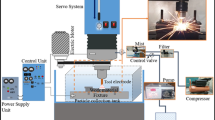Abstract
In microelectrodischarge milling (μED-milling) process, material removal occurs in the form of debris and these particles are predominantly spherical in shape with size varying from few nanometers to micrometers. The behavior of the debris particles in μED-milling is not well discussed in the literature, and this study will provide useful insight into the debris movement and its accretion on machining surfaces. Debris in its molten or cooled state will cause major issues in the μED-milling process such as secondary discharge and redeposition. Its presence at one location in large number gives rise to secondary discharge causing a disturbance in sparking, and its movement may affect the geometry of channel due to redeposition. The necessary drive for debris movement along the gap is provided by tool rotation. The experimental investigation of debris movement with dielectric at a gap of few micrometers is practically difficult due to complex phenomenon of the process. Thus, the present objective is focused to investigate the movement of debris and dielectric in the gap through simulation with consideration for fluid debris interaction and subsequent deposition. The effect of debris size, the position of injection, and the tool speed on the accretion of particles on the surface are analyzed by ANSYS Fluent. The trajectory of the particles, distance traveled, and accretion rate are calculated using discrete phase modeling. The 2D simulation results of accretion are compared with experimental surface micrographs.
Similar content being viewed by others
References
Kuneida M, Nakashima T (1998) Factors determining discharge location in EDM. Int J Electr Mach 3:53–58
Yoshida M, Kuneida M (1998) Study on the distribution of scattered debris generated by a single pulse discharge in EDM process. Int J Electr Mach 3:39–46
Wang J, Han F (2014) Simulation model of debris and bubble movement in consecutive-pulse discharge of EDM. Int J Mach Tools Manuf 77:56–65
Kuneida M, Yanatori K (1997) Study on debris movement in EDM gap. Int J Electr Mach 2:43–49
Kitamura T, Kunieda M, Abe K (2013) High-speed imaging of EDM gap phenomena using transparent electrodes. Procedia CIRP 6:314–319
Murray JW, Sun J, Patil DV, Wood TA, Clare AT (2016) Physical and electrical characteristics of EDM debris. J Mater Process Technol 229:54–60
Ayesta I, Flaño O, Izquierdo B, Sanchez JA, Plaza S (2016) Experimental study on debris evacuation during slot EDMing. Procedia CIRP 42:6–11
Cetin S, Okada A, Uno Y (2004) Effect of debris distribution on wall concavity in deep hole EDM. JSME Int J Series C 47:553–559
Liao YS, Wu PS, Liang FY (2013) Study of debris exclusion effect in linear motor equipped die-sinking EDM process. Procedia CIRP 6:123–128
Li L, Gu L, Xi X, Zhao W (2012) Influence of flushing on performance of EDM with bunched electrode. Int J Adv Manuf Technol 58:187–194
Wang K, Zhang Q, Zhu G, Liu Q, Huang Y (2017) Experimental study on micro electrical discharge machining with helical electrode. Int J Adv Manuf Technol 93:2639–2645. https://doi.org/10.1007/s00170-017-0747-6
Haas P, Pontelandolfo P, Perez R (2013) Particle hydrodynamics of the electrical discharge machining process. Part 1: physical considerations and wire EDM process improvement. Procedia CIRP 6:41–46
Okada A, Uno Y, Onoda S, Habib S (2009) Computational fluid dynamics analysis of working fluid flow and debris movement in wire EDMed kerf. CIRP Ann Manuf Technol 58:209–212
Mullya SA, Karthikeyan G (2016) Dielectric flow observation at inter-electrode gap in micro-electro-discharge-milling process. Proc IMechE Part B: J Eng Manuf:095440541666208. https://doi.org/10.1177/0954405416662082
Inthavonga K, Tua J, Heschl C (2011) Micron particle deposition in the nasal cavity using the v2-f model. Comput Fluids 51:184–188
Jafferson JM, Hariharan P, Ramkumar J (2015) Effect of non-electrical parameters in μED milling: an experimental investigation. Int J Adv Manuf Technol 85:2037–2047. https://doi.org/10.1007/s00170-015-7933-1
Karthikeyan G, Garg AK, Ramkumar J, Dhamodaran S (2012) A microscopic investigation of machining behavior in micro ED-milling process. J Manuf Process 14:297–306
Vidya S, Vijay, Barman S, Chebolu A, Nagahanumaiah, Das AK (2015) Effects of different cavity geometries on machining performance in micro-electrical discharge milling. J Micro Nano-Manuf 3:011007
Murti VSR, Philip PK (1987) An analysis of the debris in ultrasonic-assisted electrical discharge machining. Wear 117:241–250
Furutani K, Saneto A, Takezawa H, Mohri N, Miyake H (2001) Accretion of titanium carbide by electrical discharge machining with powder suspended in working fluid. Journal of the international societies for precision engineering and. Nanotechnology 25:138–144
Gatto A, Bassoli E, Denti L, Iuliano L (2013) Bridges of debris in the EDD process: going beyond the thermo-electrical model. J Mater Process Technol 213:349–360
Gatto A, Sofroniou M, Spaletta G, Bassoli E (2015) On the chaotic nature of electro-discharge machining. Int J Adv Manuf Technol 79:985–996
Ekmekci B, Sayar A (2013) Debris and consequence in micro electric discharge machining of micro-holes. Int J Mach Tools Manuf 65:58–67
Author information
Authors and Affiliations
Corresponding author
Ethics declarations
Conflict of interest
The authors declare that they have no conflict of interest.
Rights and permissions
About this article
Cite this article
Mullya, S.A., Karthikeyan, G. Accretion behavior and debris flow along interelectrode gap in μED-milling process. Int J Adv Manuf Technol 96, 4381–4392 (2018). https://doi.org/10.1007/s00170-018-1861-9
Received:
Accepted:
Published:
Issue Date:
DOI: https://doi.org/10.1007/s00170-018-1861-9




